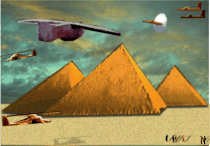Triangular Holes in Granite--Enigmatic Mooring Stones....Page 36

Article 1: Triangular Holes In Boulders
Science Frontiers Online:
Granite stone with triangular holes. Click and drag photo to resize. 
Recently, someone who wishes to remain anonymous, inspired after reading our Ancient Man, wrote us about a curious discovery of his.
He had found some triangular holes in a granite boulder near Raleigh, NC. We have mentioned similar triangular holes before (SF#69/ 20), noting that hundreds of such holes had been recorded in boulders from Minnesota and the Dakotas to the eastern seaboard. We can now add to this dossier a photograph supplemented by this individual's testimony.
"Soon after Hurricane Fran struck Raleigh in September 1996, I was walking one of my customary routes along a local creek when my attention was arrested by a ¼-ton granite boulder in the creek bed.
The boulder had 3 holes drilled in its face, about 6 inches apart, and all in a straight line. (See photo.) I had not noticed this boulder before, so I'm fairly confident it was uncovered by the storm's 10-inch deluge of rain.
Because the three holes seemed too close together to be blasting holes, I took a closer look at them and was surprised to see that they had "trianguloid" cross sections rather than round ones. By "trianguloid" I mean the cross section was thus:
Casts of the holes were made by using modeling clay. The expanded bases of the casts suggest that a shallow pit was pecked out of the granite before drilling began, and the constricted tips show that the first 3/4 inch of the drill bit was of a smaller diameter, perhaps to give it greater penetrating power so that the holes could be started more easily. The smaller "pilot" holes were also trianguloid in cross section."
(Anonymous; personal communication, May 27, 1997.)
Comment. In SF#69, it was proposed that the triangular holes were made in that shape so that wooden shafts, also of triangular cross section, could be inserted, given a quarter turn, thereby wedging the shaft firmly in place.
This idea is behind the speculation that these strange boulders are really ancient "mooring stones." In truth no one really knows how old they are and what their purpose was. The final explanation may be mundane and/or trivial.
Source:ScienceFrontiers Online

Article 2: SF #69 ..The Enigmatic "Mooring Stones"
Archeologists love to puzzle over pyramids, stone axes, and such straightforward productions of ancient man. In contrast, simple holes in boulders are hardly the things important scientific papers are written about. Yet, scattered about the Great Plains are some 300 boulders of very hard rock, each possessing the same rounded triangular holes. Surely such a phenomenon would pique some archeologist's curiosity!
Click and drag photo to resize. 
The holes are made with high precision to the dimensions shown in the figure. They are 6 inches deep, plus or minus an inch. Holes with a rounded triangular shape represent a sophisticated drilling technology. Steel tools are high craftsmanship are indicated.
Even though the holes have been known for over a century, only amateurs have shown much interest. A few such enthusiasts have tracked down hundreds in Minnesota, North Dakota, South Dakota, Illinois, and the eastern seaboard.
All of them seem to be located on present-day lakes and rivers and now-dry waterways. This marine affinity has led to the theory that they are "mooring stones," especially Viking mooring stones! In truth their real purpose is unknown.
How old are the holes? Weathering of those in granite suggest ages of at least several hundred years - well before the westward push of American settlers. The peculiar shape of the holes seems to rule out production by modern drills (usually round) for purposes of blasting or installation of surveyors' markers.
Another puzzle, probably related to the purpose of the holes, is the presence of large, smooth grooves on some of the boulders bearing the triangular holes.
The technique of "cam wedging" may lead us to the purpose of the holes. If one inserts a triangular shaft into such a hole and rotates it part of a turn, the shaft becomes firmly wedged in place.
A rotation in the opposite direction quickly frees the shaft. It does seem that the mooring-stone hypothesis is consistent with cam-wedging.
(Olson, John J.; "'Mooring Stones': An Enigma Deserving More Attention," Epigraphic Society, Occasional Publications, 18:253, 1989.)
Comment. Before climbing on the Viking bandwagon, it is reasonable to ask whether the Vikings drilled the same holes in Europe.
Source:ScienceFrontiers Online

1, 2, 3, 4, 5, 6, 7, 8, 9, 10, 11, 12, 13, 14,
15, 16,
17, 18,
19, 20,
21, 22,
23, 24,
25, 26,
27, 28,
29, 30,
31, 32,
33, 34,
35, 36,
37,
38
Next>>>


 Home
Home 20th Century Dinosaurs
20th Century Dinosaurs Dinosaurs in Literature, Art & History
Dinosaurs in Literature, Art & History Eyewitness Accounts
Eyewitness Accounts There Were Giants In The Earth in Those Days
There Were Giants In The Earth in Those Days Mega Fauna
Mega Fauna Those Sophisticated "Cave Men"
Those Sophisticated "Cave Men" Search for Noah's Ark
Search for Noah's Ark DNA, The Ultimate Oopart
DNA, The Ultimate Oopart The Bone Yards
The Bone Yards Underwater Cities, Monuments?
Underwater Cities, Monuments? Ancient Atomic Knowledge?
Ancient Atomic Knowledge? Salvation. What Must You Do To Be Saved?
Salvation. What Must You Do To Be Saved? Search
Search Links
Links Guestbook
Guestbook

